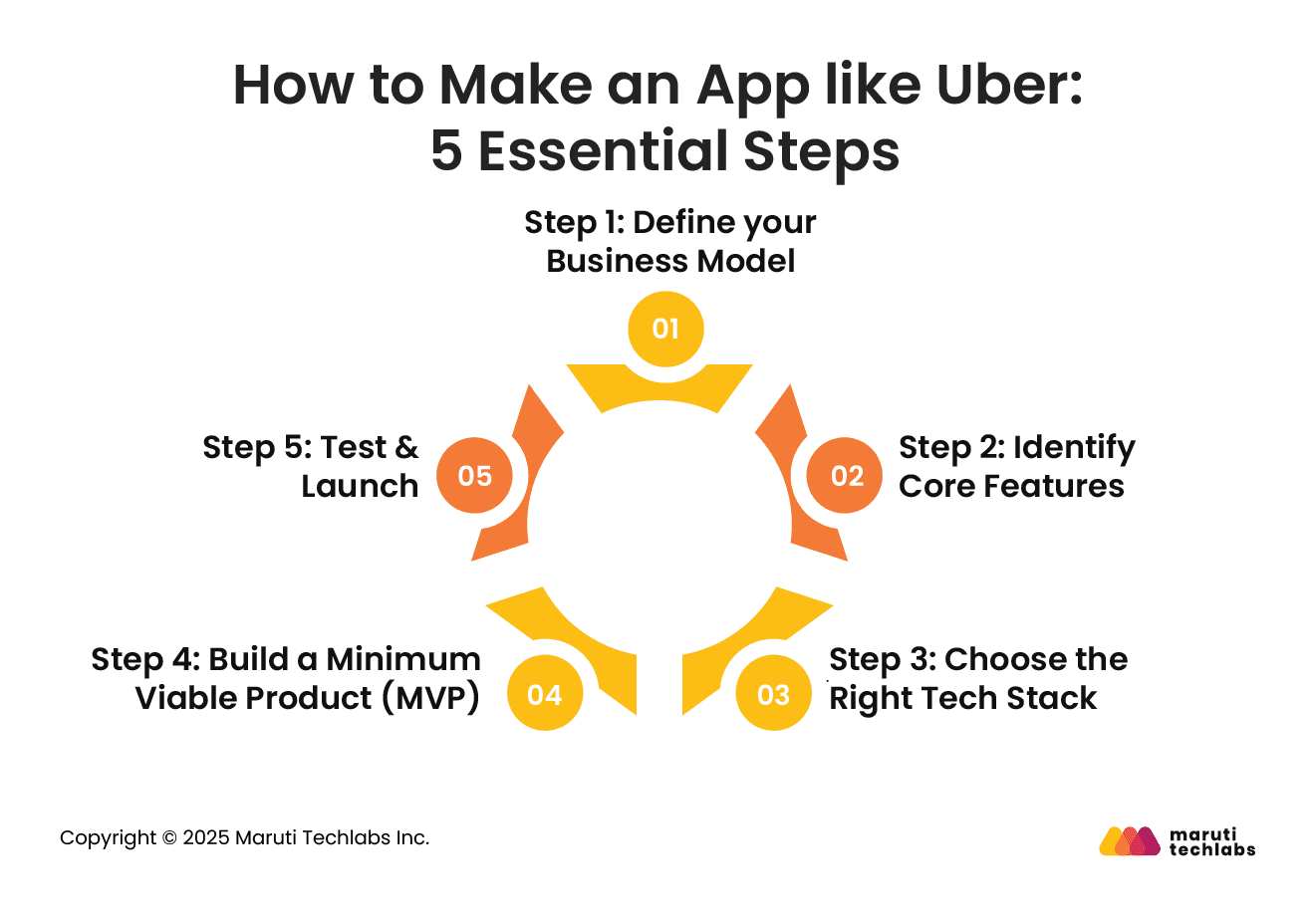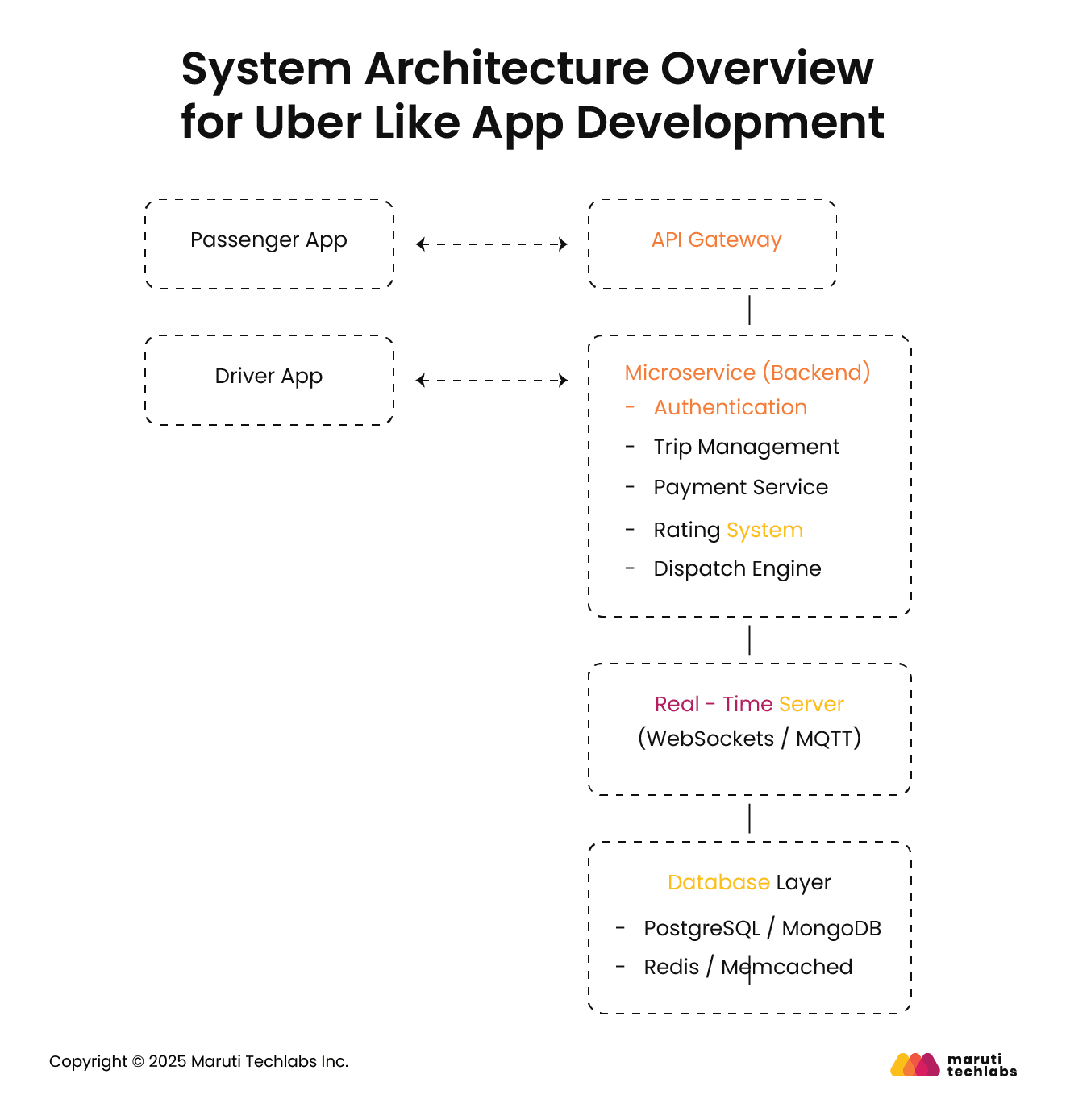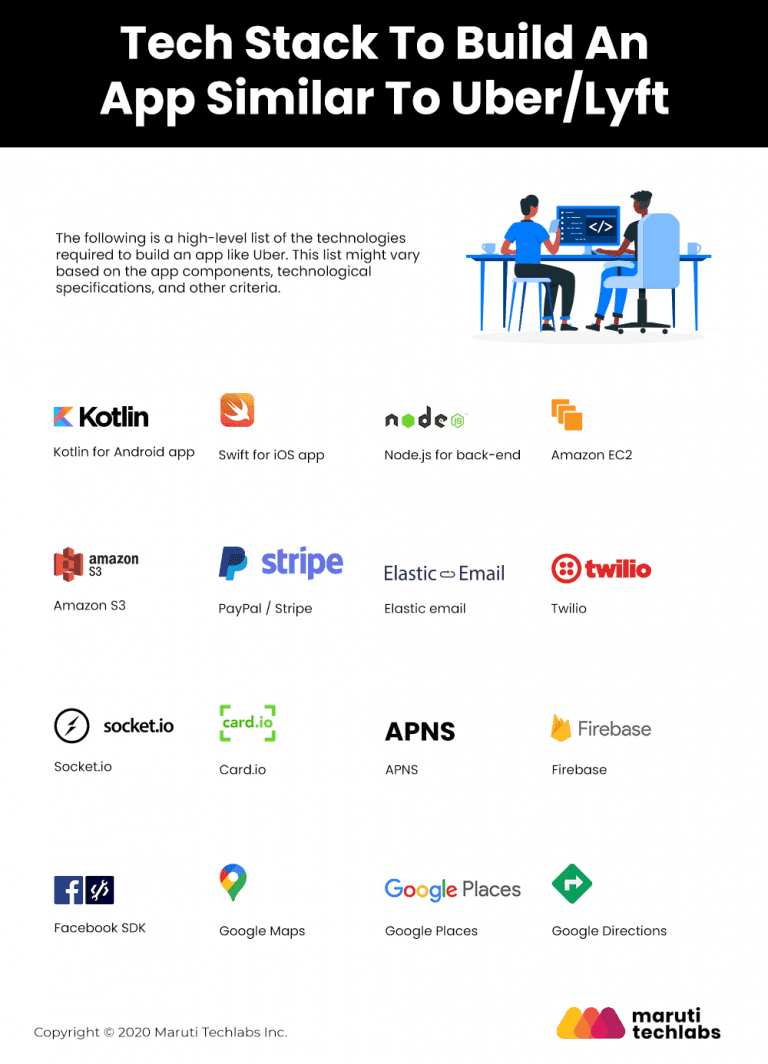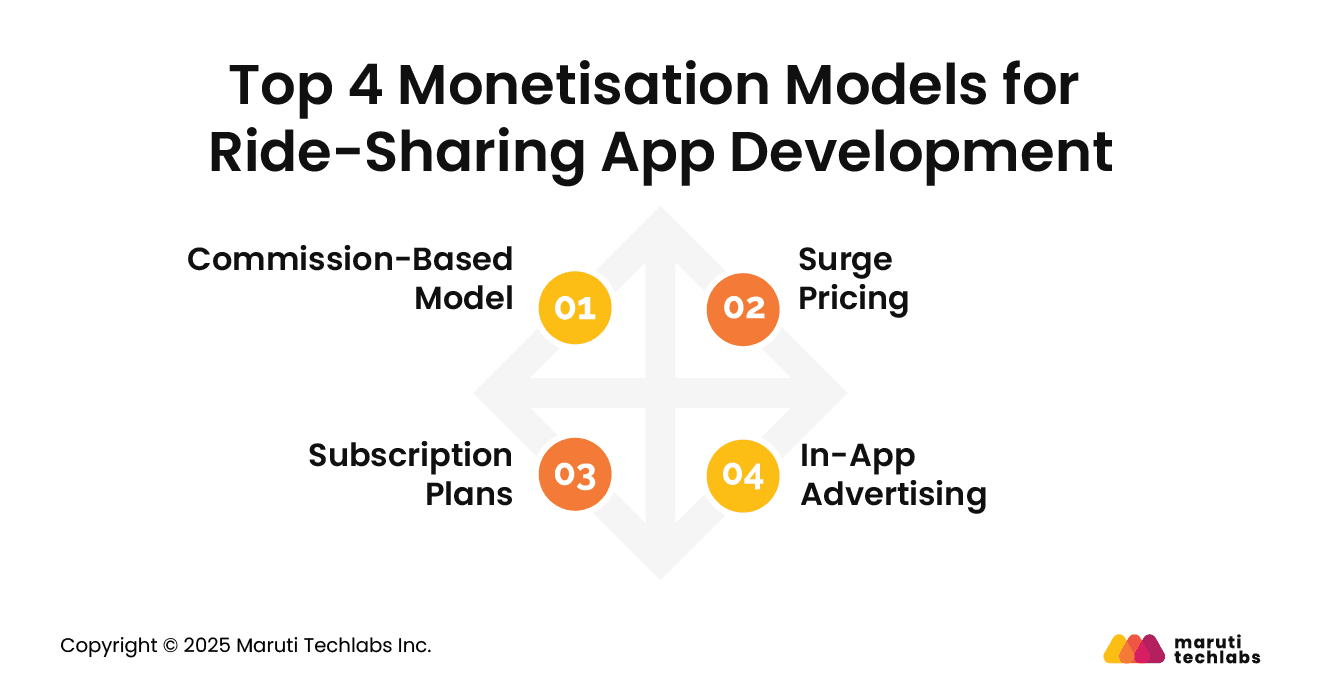

How to Build a Ride-Sharing App Like Uber: Complete Development Guide






Since its launch, Uber has redefined urban mobility, making on-demand transportation faster, safer, and more convenient. It disrupted traditional taxi systems, introduced intelligent routing, and built a scalable global model, inspiring a wave of ride-hailing innovations worldwide.
A report from Research and Markets predicts that the ride-hailing market will expand from $131.96 billion in 2024 to $157.02 billion in 2025, representing a compound annual growth rate (CAGR) of 19%.
Ride-hailing apps present a massive opportunity by addressing everyday commuting challenges, reducing traffic congestion, and promoting shared mobility. For entrepreneurs, these platforms provide scalable business models supported by real-time data, automation, and increasing user demand.
This article offers guidance on how to make an app like Uber. From development steps and must-have features to monetization strategies and key challenges, helping you navigate the path to launching a successful ride-hailing platform.
Before developing an app similar to Uber, let us understand step by step how the app works:
To develop a robust app that is easy to use for both drivers and riders, we need to include features and functionalities that benefit the users. Elucidated below is the tech stack of some of the essential functions of Uber.
Uber’s revenue generation is based on the following sources:
Do you also want to earn like Uber? Our product management consultancy. can help you achieve your revenue generation goals. With expertise in strategies such as trip commissions, surge pricing, and premium rides, our team can guide you through the process of building a successful ride-hailing app.
Uber app is an amalgamation of 3 different interfaces/apps – the Driver app, the Rider app, and the Admin panel, which manages and monitors the app’s functioning.
Let us understand the basic features of each of these applications in detail.

An Admin panel is crucial for the proper integration and smooth functioning of the system.
The basic features and functionalities of an Admin panel would be:
Developing a feature-rich apps like Uber can be difficult because of the technical complexities. But, with the top mobile app developers from an IT outsourcing company like ours, you can ensure that your app is scalable and compatible across all mobile devices.
Building a ride-hailing app like Uber in 2025 requires strategic planning, the right technologies, and a deep understanding of user needs.
Here’s a step-by-step guide to help you get started:
Begin by choosing a business model: peer-to-peer (like Uber), corporate partnerships, or niche services (e.g., luxury, women-only rides, carpooling). Decide on pricing, commission structure, and regional focus. Clearly defining your model ensures that the app addresses a genuine market pain point.
Design separate apps for passengers and drivers. For passengers: real-time ride booking, fare estimates, driver tracking, payment integration, and reviews.
For drivers: trip requests, route navigation, earning dashboards, and access to support. Admin dashboards for operations and analytics are also essential.
Select scalable technologies: React Native or Flutter for cross-platform apps, Node.js or Django for the backend, Google Maps API for geolocation, Firebase or AWS for cloud services, and Stripe or Razorpay for payments.

Start with an MVP to validate your concept. Include essential features, ensure an intuitive user experience, and integrate only the necessary tools. An MVP helps gather user feedback and minimizes initial development costs.
Conduct thorough QA testing, focus on usability, GPS accuracy, payment reliability, and app speed. Soft-launch in a limited region, iterate based on feedback, and scale gradually. Continuous updates and support are key to long-term success.
Uber utilizes a combination of programming languages to power its platform, each selected for its specific performance and scalability requirements.
For its dispatch system, Uber utilizes Node.js due to its event-driven architecture, which enables the real-time processing of millions of ride requests with minimal latency.
On the backend, Uber relies on Python for data-heavy operations and experimentation, Go for its high performance and concurrency handling, and Java for building scalable, enterprise-grade services that support millions of users globally.
For the mobile apps, Uber initially used Objective-C for iOS and Java for Android. Over time, they’ve adopted Kotlin for Android to improve code safety and maintainability.
This polyglot approach helps Uber ensure high performance, scalable infrastructure, and faster feature development across its complex ecosystem, supporting a real-time, high-demand ride-hailing experience worldwide.


To build a sustainable and profitable ride-sharing app, selecting the right monetisation strategies is key.
Here are four effective models to choose from:
This is the core revenue stream where the platform takes a percentage cut from every ride fare. For example, Uber typically charges drivers a 20–25% commission per trip.
Dynamic pricing is applied during high-demand periods (e.g., rush hours, bad weather). It incentivizes more drivers to get online while increasing profits through increased fares.

Users can pay a fixed monthly fee for perks like discounted rides, priority booking, or zero cancellation charges. This model ensures recurring revenue and customer loyalty.
Displaying targeted ads to users in the app generates additional revenue. Brands can also partner to promote services, offers, or driver incentives.
Creating a ride-sharing app like Uber is a complex process that involves more than just building user-friendly interfaces. Several challenges must be addressed to ensure the platform is reliable, secure, and scalable.
Accurate GPS tracking is critical for matching riders with nearby drivers and estimating arrival times. However, GPS drift in urban areas, network delays, and location spoofing can disrupt the user experience.
Ride-sharing apps must support multiple secure payment options like cards, wallets, UPI, and more. Ensuring seamless integration, transaction speed, refund handling, and compliance with PCI-DSS standards can be challenging.
Implementing safety features like SOS buttons, live trip tracking, driver background checks, and two-way ratings requires robust tech and operational protocols. Balancing privacy and security is key.

Transport laws vary widely by region. Companies must navigate licensing, driver classification, insurance, and data protection laws to avoid legal roadblocks.
Handling thousands of concurrent users, ride requests, and real-time data without system lag requires a scalable infrastructure. Poor backend optimization can lead to crashes and lost revenue.
Solving these challenges is essential for building a trusted and high-performing ride-hailing platform.
Building an Uber-like ride-hailing app requires more than just great code, it demands industry insight, real-time architecture expertise, and user-centric design. At Maruti Techlabs, we bring all that and more to the table.
We’ve successfully built and deployed complex, real-time platforms, such as our roadside assistance app, which mirrors the core functionalities of ride-sharing apps. It has features like real-time driver tracking, service dispatching, payment integration, and customer support. This hands-on experience gives us a solid foundation in location-based service apps.
Our cross-functional team of developers, architects, designers, and QA engineers specialize in building scalable, secure, and intuitive mobile and web applications. Our experts are proficient with using modern tech stacks (Flutter, Node.js, React, AWS, etc.) and agile development practices to ensure faster time to market and seamless user experiences.
What sets us apart is our Software Product Engineering Services. We don’t just write code, we help shape your product strategy, optimize your MVP, and support your app post-launch with continuous updates and analytics.
If you're looking for mobile app development Chicago services that are reliable and experienced to build your Uber-like app, you’re just at the right place. Connect with us today, to see how we can help you bring your vision to life.
As this article earlier states, the timeline of the development of different features depends on various factors like technological preferences, the number of developers involved, their capabilities, number of features, and overall app complexity. Approximately, building an app like Uber can take anywhere between 2 to 5 months.
Uber’s engineers primarily write in Python, Node.js, Go, and Java. They started with two main languages: Node.js for the Marketplace team, and Python for everyone else.
The price to develop an app like Uber is roughly $200,000+. The final system cost changes due to the complexity of these elements, their design specifics, integrations, components used, as well as rates of the IT vendor you work with.
The convenience and speed that comes with on-demand service providers ensure that there is no dearth of customers for such businesses. Not only is the Uber for X solution user-friendly, but it will also help you in managing your employees efficiently and streamlining your business activities.
Like Uber’s disruptive business model, Uber for X will fit perfectly in the on-demand economy and simplify the delivery of your services/goods.
Uber's success story is a testament to the power of strategic adjustments in transforming a basic idea, such as a ride-booking app, into a lucrative business. A well-crafted product strategy is essential for businesses seeking to emulate Uber's success and build a similar app. By conducting market research, identifying customer needs, and devising a comprehensive plan for product development, marketing, and sales, you can maximize your chances of success in the ride-booking industry.
With more than a decade of experience in developing mobile applications, we at Maruti Techlabs provide impeccable service to our clients. Our app experts can guide you on market trends and the latest technologies to adapt your app idea. We help you grow your business and develop a loyal customer base by developing high-quality applications for web platforms, iOS, and Android.

Whether you are looking for the business perspective or the technical know-how, we at Maruti Techlabs are more than eager to know your idea and share our decade-long experience and knowledge in app development. Simply drop us a note here, and we’ll take it from there.


